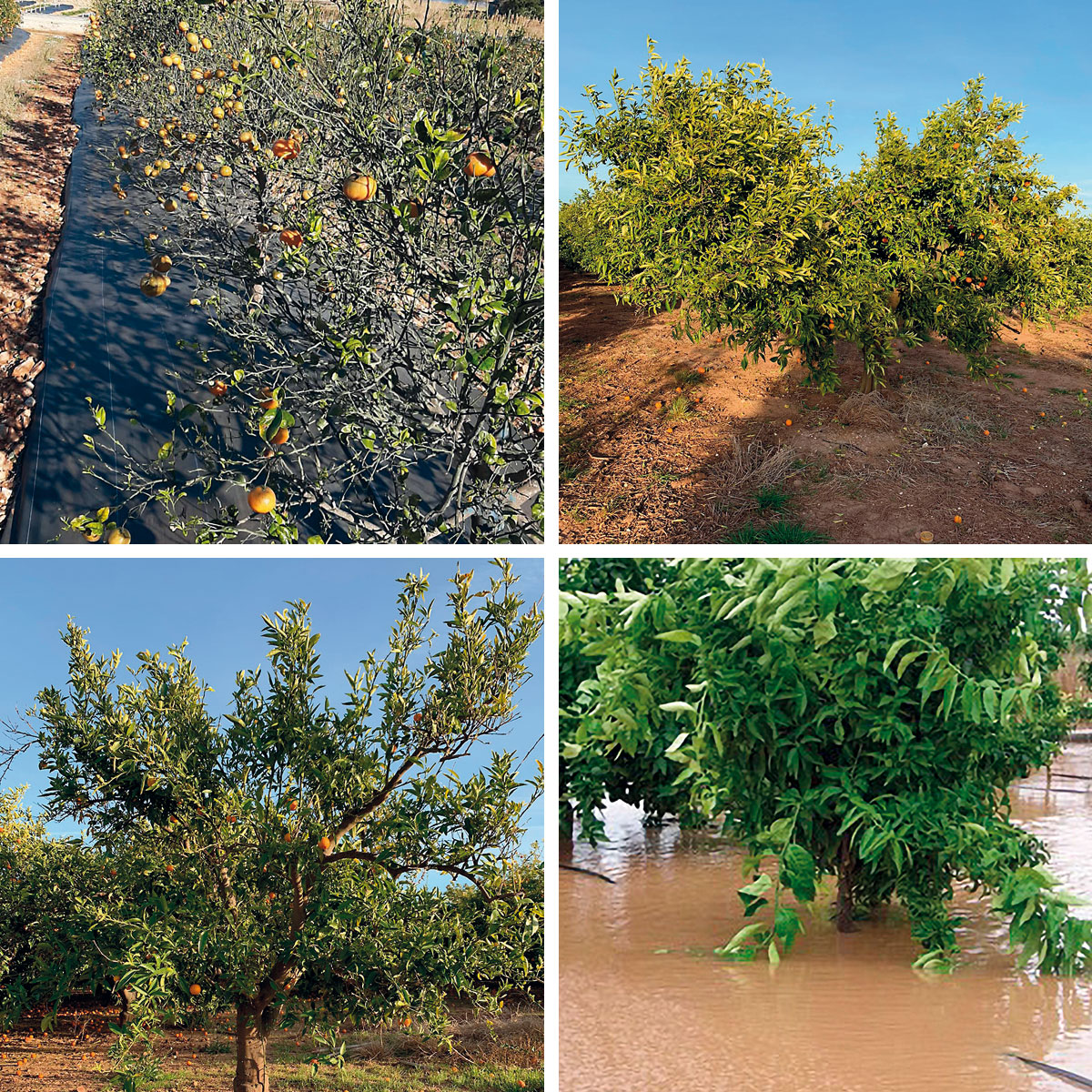The future of citrus fruit
The impact of climate change on citriculture

Current citriculture is threatened by climate change. The increase in temperature, together with other adverse climate phenomena, is modifying the environmental conditions in the regions where citrus varieties are currently being developed. The detrimental effects of these adverse environmental factors on citrus physiology and production, such as drought or augmented soil salinity, will likely increase because of elevated temperatures, which will jeopardise crop production and, in extreme cases, even plant survival. Studying citrus tolerance responses to climate change may hold the key to developing new citrus varieties capable of withstanding future environmental conditions while still maintaining production.
Keywords: elevated temperatures, plant physiology, selective breeding, salinity, drought, citrus.
Introduction
Plants are sessile organisms so they must adapt to the environment and cannot flee or find shelter from adverse environmental conditions. When faced with a changing environment, plants activate genetic, biochemical, physiological, and morphological response mechanisms to survive and develop in suboptimal conditions (Figure 1). However, these adaptation responses have a physiological and energy cost to plants, and when the plants in question are crops, this translates into a decrease in production. Global climate change, driven by the increase in greenhouse gas emissions, among other factors, is causing the average temperature of the planet to increase. However, increased temperature is not the only consequence; important changes to several climate factors are accumulating. Some of the most significant of these changes are the increases in extreme weather events (which can be especially harmful to agriculture), heatwave intensity and frequency, severe drought events, and flooding after torrential rains (IPCC, 2014).

Figure 1. The main abiotic stressors in citrus cultivation. The average temperature of the planet is rising because of climate change, but the consequences for citriculture are not limited to temperature. Some of the most significant changes are the increase in extreme weather events, severe drought events, or flooding after torrential rains. In addition, in Mediterranean regions, the rise in temperatures will increase irrigation needs, which implies intensified pressure on aquifers and, in turn, increased salinisation. All these factors have negative consequences for citrus cultivation. / Illustration: Vecteezy.com
Citrus trees belong to the Citroideae subfamily within the Rutaceae family. Most cultivated citrus species belong to the genus Citrus, which originated in ancient Asia and was exported to southern Europe and, from there, to the rest of the world. Citruses are one of the most important crop types around the world, with extensive citrus fields in the subtropical regions of the Americas, South Asia, Southern Africa, and Australia. They are also an important crop in Mediterranean climates, both in Europe and in other continents. Spain is the world’s sixth largest producer of fresh citrus and is the leading exporter of oranges, mandarins, and lemons. On a productive and commercial level, mandarins and clementines are the most distinctive hallmark of the Spanish citrus supply, with a volume exceeding two million tonnes per season, mainly concentrated in the provinces of Valencia and Castellón. In recent campaigns, Spain exceeded a production of 6.4 million tonnes of citrus fruit and Spanish citrus exports exceeded 3.7 million tonnes, 68 % of which corresponded to the Valencian Community, making citriculture one of its largest incomes from among its national exports. According to the data collected in the 2020 Crop Surface Area and Yields Survey (ESYRCE in its Spanish initialism), Spain has more than 300,000 hectares cultivated with citrus trees, over half of which correspond to the Valencian Community.
In today’s citriculture, cultivated trees are actually the combination of two plants: a productive variety is grafted onto a rootstock, corresponding to the lower part of the trunk and the root system. This technique is used because some varieties with high agronomic value and high yields (for example, with longer productive periods and larger fruit size, production, and organoleptic quality) often have low tolerance to soil salinity, drought, high pH levels, flooding, or pests. The combination of a very resistant rootstock and a variety with fruits of high-quality often guarantees longer tree durability and improves crop production and management. This technique also helps to anticipate fruit production in several years.
Generally speaking, citrus trees adapt well to different climates, but their growth is limited by low temperatures and frost. In Mediterranean regions, the rise in temperatures caused by climate change will lead to higher evapotranspiration, lower rainfall, and, consequently, increased irrigation needs for this crop that already has high needs of irrigation. For many cultivated areas, increased irrigation implies putting greater pressure on aquifers, which in turn leads to salinisation as a result of increased seawater intrusion, especially in coastal areas such as the Mediterranean basin. Moreover, prolonged use of salinised water for irrigation leads to permanent soil degradation from the dispersion of soil aggregates. Thus, citrus agriculture will have to cope with a generalised increase in the frequency and intensity of drought periods, degradation, salinisation of arable soils, and rising temperatures as a result of climate change.
Interaction between the environment and citrus development
Some of the most harmful abiotic1 factors impacting citrus production are extreme temperature changes, drought, flooding, and the salinity of irrigation water and substrates, which are all linked to climate change, as described above (Figure 2). High temperatures affect citrus plants, increasing transpiration and photosynthesis, destabilising their cell membranes, and incrementing oxidative damage. The optimal temperature range for citrus cultivation is estimated to be 22–34 °C. Temperatures above this range lead to fruit abscission and smaller fruit size. Organoleptic quality parameters such as the total soluble solids content (TSS) and total titratable acidity (TTA), are also affected. Moreover, the worse these factors become, the lower the commercial value of the yield.
However, while fruit size is strongly affected, the vegetative growth of citrus plants does not seem to suffer as much due to elevated temperatures, with several citrus species being able to withstand temperatures exceeding 40 °C without showing detrimental physiological or biochemical effects (Pereira et al., 2017; Zandalinas et al., 2016; Zandalinas et al., 2017). Citrus species have different acclimation responses to hot temperatures. However, climate change increases the likelihood of cold albeit short episodes. A pronounced decrease in temperatures (especially below freezing) can result in production losses, especially when these events occur during the flowering period when the tree is particularly vulnerable to low temperatures.

Figure 2. Some of the most harmful abiotic factors impacting citrus production are extreme temperature changes, drought, flooding, and the salinity of the irrigation water and substrate, all of which are linked to climate change. The images show the effects of abiotic stress in citrus crops. From left to right and top to bottom: defoliation resulting from substrate salinity; leaf yellowing and curling caused by drought; leaf and fruit abscission due to drought and elevated temperatures; and leaf yellowing because of prolonged flooding. / Photos: Damián Balfagón, Vicent Arbona, and Aurelio Gómez-Cadenas
As previously mentioned, severe droughts are also associated with climate change. Indeed, a lack of available water negatively affects the growth and reproductive processes of citrus trees, consequently resulting in a lower yield. Moreover, water deficits during the period of fruit formation and growth leads to reduced fruit size and quality and increases abscission losses (Romero et al., 2006). Citrus fruits respond to this stress by closing their stomata to reduce transpiration and minimise water loss. Similarly, CO2 uptake and photosynthesis are also reduced, which can destabilise the electron transport chain and cause increased oxidative damage. Another effect of water scarcity is increased osmotic pressure, which makes it more difficult to maintain water flow to the plant’s tissues. To counteract this problem, citrus plants accumulate osmoprotective compounds such as inorganic salts, the amino acid proline, or carbohydrates such as raffinose (Gimeno et al., 2009). As physiological and biochemical strategies to cope with water deficits, plants reduce their transpiration and accumulate osmoprotective compounds. Other plant responses include variations in cell wall elasticity, phytohormone overaccumulation, or increased cellular antioxidant activity (Balfagón, Zandalinas, et al., 2019; Gonçalves et al., 2016). All these responses allow the plant to overcome adverse conditions, but this physiological effort is not devoid of cost and, when prolonged over time, it negatively affects tree growth and the fruit harvest.
High saline concentrations in irrigation water, caused by the salinisation of aquifers and irrigation wells, have a series of impacts on citrus plants. Firstly, they reduce seed germination and curb vegetative growth. In addition, they cause chlorosis, necrosis, and finally, leaf abscission (Gómez-Cadenas et al., 2015), thus decreasing the total leaf surface area. Secondly, high salt concentrations in irrigation water or in the soil cause nutritional mismatches and the accumulation of Cl– ions (which are toxic to citrus plants) in the leaves. Finally, saline stress causes plants to reduce the stomata opening, partly because of abscisic acid phytohormone (ABA) signalling and decreased photosynthetic activity (Gómez-Cadenas et al., 2015; López-Climent et al., 2008). Alteration of photosynthesis breaks down the electron transport chain and increases the production of reactive oxygen species (ROS) (Arbona et al., 2003). In addition, reduced photosynthesis might also activate the photorespiration process in peroxisomes, resulting in the production of more oxidative molecules such as H2O2.
Another tangible consequence of climate change is an increase in the number and duration of torrential rain episodes. The prolonged soil flooding caused by these events has many negative consequences for crops. The main effect is a reduction in available oxygen in the substrate, but other effects include changes in the chemical composition of the soil which affect plant interactions (changes in redox potential, nutrient availability, or microbiota; Sauter, 2013). The effects of flooding on citrus plants include inhibition of plant growth and development, leaf abscission and yellowing, and stem death. These symptoms are partly explained by reduced transpiration, photosynthesis, and water potential as well as apoplast acidification (Vincent et al., 2020). Some cultivated plant species (such as rice, soy, tomato, etc.) have acquired different adaptation mechanisms to flooding such as the development of aerial roots, stem elongation, or the formation of aerenchyma – a parenchymatic tissue that allows gas circulation. However, citrus plants have no specific adaptations for prolonged flooding and the differences observed between varieties and rootstocks have been attributed to variations in their ability to maintain transpiration and photosynthesis (Arbona et al., 2009). In general, the most vigorous genotypes and those with the highest transpiration rates are more tolerant to prolonged flooding periods, and rootstocks can transfer this higher tolerance to the grafted variety.
The threat of rising temperatures
The increase in temperature expected in citrus cultivation areas is not a direct threat to plant growth and development. However, it is harmful for fruit formation and development. In addition, the consequences of this increased temperature could compromise the ability of plants to tolerate other changing environmental factors. Increased water needs, as a consequence of higher temperatures, would result in greater vulnerability to droughts; it also increases the amount of irrigation water needed to properly manage the crop. In turn, increased water use often involves the overexploitation of aquifers, intrusion of salt water into these water stores, and ultimately, farmland salinisation. Therefore, together with stressors related to high temperatures, other adverse conditions connected to water deficiency or the use of salt water for irrigation might also appear. Numerous studies have shown that two or more simultaneous stresses on the plant can cause a new stress situation with specific plant responses (reviewed in Balfagón et al., 2020 and Zandalinas et al., 2018). The concurrence of multiple stressors can sometimes positively affect plant development, although most studies indicate that a combination is more harmful to plants than individual stressors. More specifically, studies with citrus plants have shown that tolerable drought or salinity conditions can become lethal when combined with higher temperatures (Balfagón, Zandalinas, et al., 2019; Zandalinas et al., 2016). This poses a danger for citriculture in many global regions where these plants are the main crops because a significant increase in the average temperature is expected in these regions and represents a higher risk of drought or salinisation. The Mediterranean basin experiences extended periods of drought, and irrigation is key to maintain citrus fields. Thus, many of these areas suffer from problems related to the salinisation of groundwater, resulting from the overexploitation of aquifers and the intrusion of seawater.
«The consequences of the increase in temperature can compromise the plants’ ability to tolerate other changing environmental factors»
The physiological responses of citrus plants to drought include stomatic closure and reduced transpiration to help plants maintain their water status by reducing water loss to the atmosphere. However, this response is contrary to one of the main mechanisms of tolerance to elevated temperatures: opening stomata to increase transpiration and cool the leaves. Thus, the simultaneous occurrence of both stressors represents a real challenge for the survival of the plant. Recent studies analysing the tolerance of citrus rootstocks to a combination of drought and high temperatures proved that those with a higher tolerance to these combined stressors maintained high photosynthesis and transpiration rates, despite low water availability. This enhances leaf cooling and prevents heat damage (Zandalinas et al., 2016). In addition to the physiological response to the combination of droughts and high temperatures, biochemical responses have also been determined which include activation of the antioxidant enzyme system (thereby reducing oxidative damage from stress) or the accumulation of protective proteins such as chaperones (Balfagón et al., 2018; Zandalinas et al., 2017).
The combination of salinity and elevated temperatures represents an additional problem for citrus plants. One of their main mechanisms of tolerance to salinity is to prevent root absorption of toxic Cl– ions and their translocation to the aerial section of the plant. To do this, citruses minimise their physiological activity by reducing their stomatic opening, transpiration, and root water absorption, all of which are the opposing responses to high temperatures. A recent study analysing the response of a relatively salinity-resistant rootstock (citrange Carrizo) to combined heat and salinity conditions showed that physiological responses to hot temperatures prevailed. In other words, the stomata opened and the plant increased transpiration to cope with the temperature stress, which led to greater leaf Cl– accumulation and increased sensitivity to salinity (Balfagón, Zandalinas, et al., 2019).
|
CITRICULTURE IN THIMES OF CLIMATIC CHANGE |
|
| Threats | Adaptation |
| Increased oxidative damage
Decreased photosynthesis Reduced growth Increased sensitivity to drought Loss of production Salinisation Crop soil deterioration |
Scientific knowledge Variety breeding Rootstock breeding Cultivation techniques Resource optimisation |
Future challenges in citriculture
Environmental conditions are constantly changing, and plant species have always adapted to them. However, we are faced with a shift in the climate model. This may affect crops traditionally linked to particular regions of the planet because of environmental conditions if the optimal conditions for which they were selected no longer exist. This is the case of citrus cultivars which can suffer physiological problems leading to a loss of productivity and fruit quality as a result of climate change and the concurrence of environmental stressors such as elevated temperatures, droughts, flooding, or soil salinisation and degradation.
Studying the effect of a combination of stressors on plants (with high temperatures as a common factor) has allowed us to understand the natural mechanisms of resistance to complex stress situations (Balfagón et al., 2020; Suzuki et al., 2014; Zandalinas et al., 2018). If citrus plants are to tolerate periods of high temperatures combined with drought or high irrigation water salinity, then correct regulation of the plants’ gas exchange to mitigate the effects of high temperatures, the accumulation of antioxidant compounds (together with a reduction in oxidative damage), adequate hormonal balance, and the overexpression of key tolerance genes are essential responses (Balfagón et al., 2018; Balfagón, Zandalinas, et al., 2019; Zandalinas et al., 2016).
«We must develop new varieties that will maintain production and fruit quality in the face of extreme climate phenomena»
Despite advances in our knowledge of the mechanisms of citrus tolerance to combined stress conditions, other abiotic and biotic factors that could be a threat to these crops in the coming years must still be evaluated, especially in warmer environments. Indeed, studying some of these stress situations in other model species and crops of agronomic interest has indicated some of the potential negative effects they could have on citrus production (Balfagón, Sengupta, et al., 2019; Pandey et al., 2017).
Thus, recent advances must be used to generate new varieties and rootstocks that will allow current citrus crops to adapt and become sustainable (Figure 3). Therefore, we must develop new varieties that maintain production and fruit quality in the face of extreme climate phenomena and new rootstocks more resistant to heat, drought, and soil impoverishment. The implementation of cultivation techniques that favour the optimisation of irrigation water and minimise soil degradation will also be essential.
Notes
1. Abiotic factors are those not related to the plant’s interaction with other living beings. (Go back)
References
Arbona, V., Flors, V., Jacas, J., García-Agustín, P., & Gómez-Cadenas, A. (2003). Enzymatic and non-enzymatic antioxidant responses of Carrizo citrange, a salt-sensitive citrus rootstock, to different levels of salinity. Plant & Cell Physiology, 44(4), 388–394. https://doi.org/10.1093/pcp/pcg059
Arbona, V., López-Climent, M. F., Pérez-Clemente, R. M., & Gómez-Cadenas, A. (2009). Maintenance of a high photosynthetic performance is linked to flooding tolerance in citrus. Environmental and Experimental Botany, 66(1), 135–142. https://doi.org/10.1016/j.envexpbot.2008.12.011
Balfagón, D., Sengupta, S., Gómez-Cadenas, A., Fritschi, F. B., Azad, R. K., Mittler, R., & Zandalinas, S. I. (2019). Jasmonic acid is required for plant acclimation to a combination of high light and heat stress. Plant Physiology, 181(4), 1668–1682. https://doi.org/10.1104/pp.19.00956
Balfagón, D., Zandalinas, S. I., Baliño, P., Muriach, M., & Gómez-Cadenas, A. (2018). Involvement of ascorbate peroxidase and heat shock proteins on citrus tolerance to combined conditions of drought and high temperatures. Plant Physiology and Biochemistry, 127, 194–199. https://doi.org/10.1016/j.plaphy.2018.03.029
Balfagón, D., Zandalinas, S. I., & Gómez-Cadenas, A. (2019). High temperatures change the perspective: Integrating hormonal responses in citrus plants under co-occurring abiotic stress conditions. Physiologia Plantarum, 165(2), 183–197. https://doi.org/10.1111/ppl.12815
Balfagón, D., Zandalinas, S. I., Mittler, R., & Gómez-Cadenas, A. (2020). High temperatures modify plant responses to abiotic stress conditions. Physiologia Plantarum, 170(3), 335–344. https://doi.org/10.1111/ppl.13151
Gimeno, J., Gadea, J., Forment, J., Pérez-Valle, J., Santiago, J., Martínez-Godoy, M. A., Yenush, L., Bellés, J. M., Brumós, J., Colmenero-Flores, J. M., Talón, M., & Serrano R. (2009). Shared and novel molecular responses of mandarin to drought. Plant Molecular Biology, 70, 403–420. https://doi.org/10.1007/s11103-009-9481-2
Gómez-Cadenas, A., Vives, V., Zandalinas, S. I., Manzi, M., Sánchez-Pérez, A. M., Pérez-Clemente, R. M., & Arbona, V. (2015). Abscisic acid: A versatile phytohormone in plant signaling and beyond. Current Protein and Peptide Science, 16(5), 413–434. https://doi.org/10.2174/1389203716666150330130102
Gonçalves, L. P., Alves, T. F. O., Martins, C. P. S., de Sousa, A. O., dos Santos, I. C., Pirovani, C. P., Almeida, A. F., Filho, M. A. C., Gesteira, A. S., Soares Filho, Walter dos S., Girardi, E. A., & Costa, M. G. C. (2016). Rootstock-induced physiological and biochemical mechanisms of drought tolerance in sweet orange. Acta Physiologiae Plantarum, 38(7), 174. https://doi.org/10.1007/s11738-016-2198-3
IPCC. (2014). Climate change 2014: Synthesis report. IPCC.
López-Climent, M. F., Arbona, V., Pérez-Clemente, R. M., & Gómez-Cadenas, A. (2008). Relationship between salt tolerance and photosynthetic machinery performance in citrus. Environmental and Experimental Botany, 62(2), 176–184. https://doi.org/10.1016/j.envexpbot.2007.08.002
Pandey, P., Irulappan, V., Bagavathiannan, M. V., & Senthil-Kumar, M. (2017). Impact of combined abiotic and biotic stresses on plant growth and avenues for crop improvement by exploiting physio-morphological traits. Frontiers in Plant Science, 8, 537. https://doi.org/10.3389/fpls.2017.00537
Pereira, F. F. S., Sánchez-Román, R. M., & Orellana González, A. M. G. (2017). Simulation model of the growth of sweet orange (Citrus sinensis L. Osbeck) cv. Natal in response to climate change. Climatic Change, 143(1), 101–113. https://doi.org/10.1007/s10584-017-1986-0
Romero, P., Navarro, J. M., Pérez-Pérez, J., García-Sánchez, F., Gómez-Gómez, A., Porras, I., Martinez, V., & Botía, P. (2006). Deficit irrigation and rootstock: Their effects on water relations, vegetative development, yield, fruit quality and mineral nutrition of Clemenules mandarin. Tree Physiology, 26, 1537–1548. https://doi.org/10.1093/treephys/26.12.1537
Sauter, M. (2013). Root responses to flooding. Current Opinion in Plant Biology, 16(3), 282–286. https://doi.org/10.1016/j.pbi.2013.03.013
Suzuki, N., Rivero, R. M., Shulaev, V., Blumwald, E., & Mittler, R. (2014). Abiotic and biotic stress combinations. New Phytologist, 203(1), 32–43. https://doi.org/10.1111/nph.12797
Vincent, C., Morillon, R., Arbona, V., & Gómez-Cadenas, A. (2020). Citrus in changing environments. In M. Talon, M. Caruso, & F. G. Gmitter Jr. (Eds.), The genus Citrus (pp. 271–289). Elsevier. https://doi.org/10.1016/B978-0-12-812163-4.00013-9
Zandalinas, S. I., Balfagón, D., Arbona, V., & Gómez-Cadenas, A. (2017). Modulation of antioxidant defense system is associated with combined drought and heat stress tolerance in citrus. Frontiers in Plant Science, 8, 953. https://doi.org/10.3389/fpls.2017.00953
Zandalinas, S. I., Mittler, R., Balfagón, D., Arbona, V., & Gómez-Cadenas, A. (2018). Plant adaptations to the combination of drought and high temperatures. Physiologia Plantarum, 162(1), 2–12. https://doi.org/10.1111/ppl.12540
Zandalinas, S. I., Rivero, R. M., Martínez, V., Gómez-Cadenas, A., & Arbona, V. (2016). Tolerance of citrus plants to the combination of high temperatures and drought is associated to the increase in transpiration modulated by a reduction in abscisic acid levels. BMC Plant Biology, 16, 105. https://doi.org/10.1186/s12870-016-0791-7





